MBK7004M - Successful Strategic Thinking: Theory, Implementation
VerifiedAdded on 2023/06/18
|22
|7102
|293
Report
AI Summary
This report delves into the realm of successful strategic thinking, drawing upon key theories and models such as Porter's Five Forces and the Ansoff Matrix. It critically analyzes strategic processes within organizations, examining how individuals contribute to strategy development and implementation. The report offers recommendations for enhancing strategic processes, new product development and NPD systems within organizations, aiming to improve overall performance and adaptability in dynamic environments. The analysis incorporates practical examples and personal experiences, providing a comprehensive understanding of strategic thinking and its application in real-world scenarios. Desklib provides solved assignments for students.
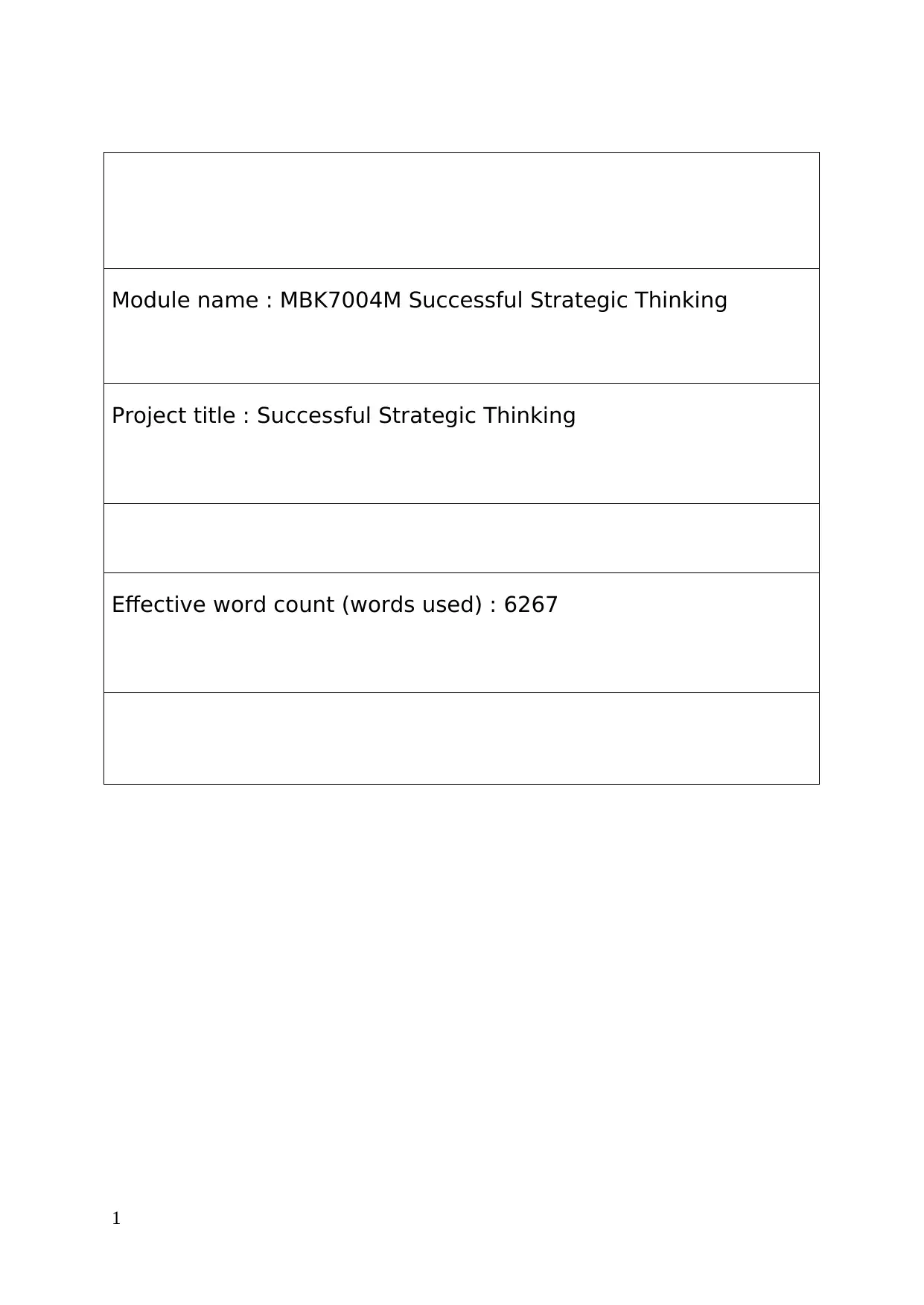
Module name : MBK7004M Successful Strategic Thinking
Project title : Successful Strategic Thinking
Effective word count (words used) : 6267
1
Project title : Successful Strategic Thinking
Effective word count (words used) : 6267
1
Paraphrase This Document
Need a fresh take? Get an instant paraphrase of this document with our AI Paraphraser
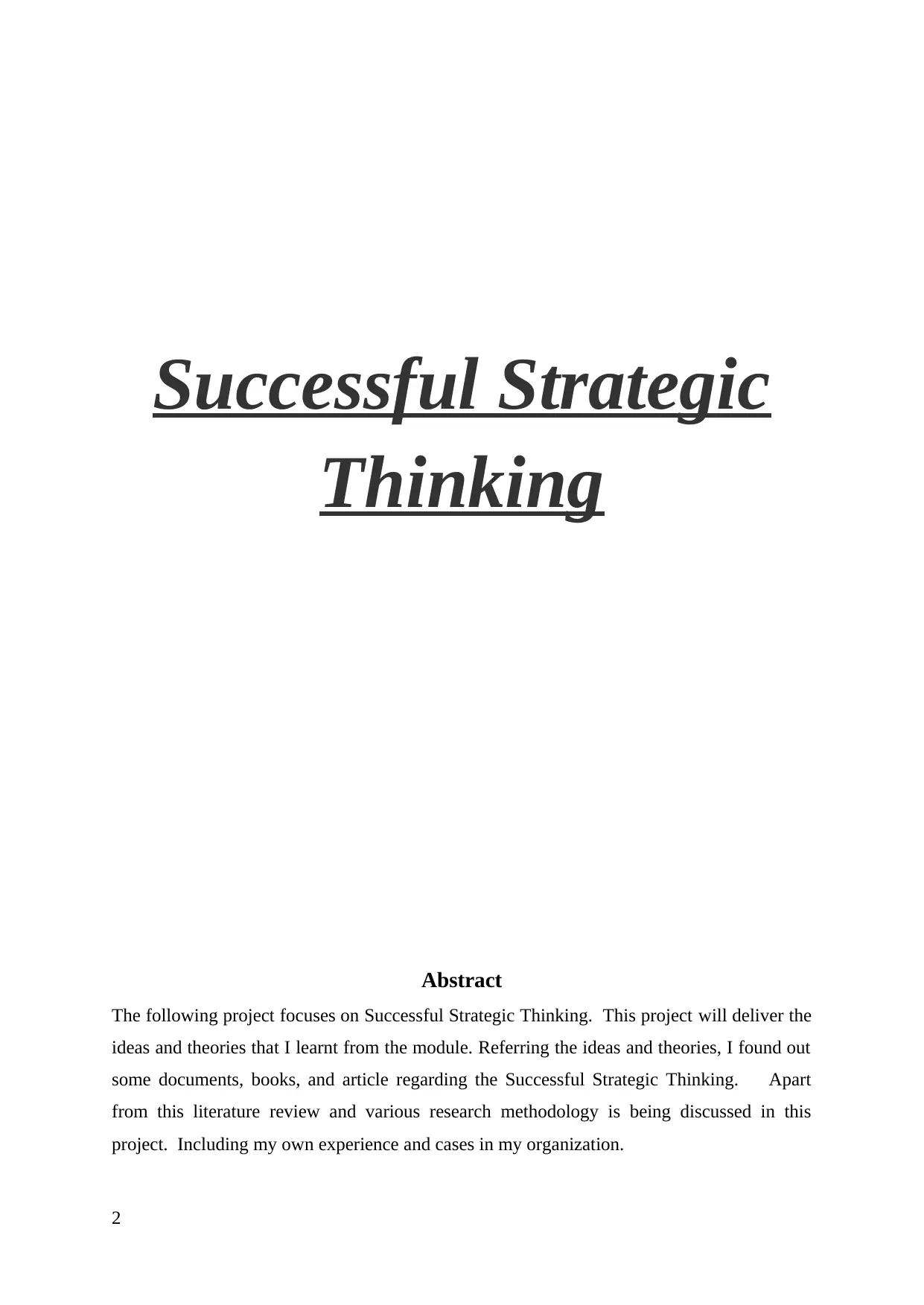
Successful Strategic
Thinking
Abstract
The following project focuses on Successful Strategic Thinking. This project will deliver the
ideas and theories that I learnt from the module. Referring the ideas and theories, I found out
some documents, books, and article regarding the Successful Strategic Thinking. Apart
from this literature review and various research methodology is being discussed in this
project. Including my own experience and cases in my organization.
2
Thinking
Abstract
The following project focuses on Successful Strategic Thinking. This project will deliver the
ideas and theories that I learnt from the module. Referring the ideas and theories, I found out
some documents, books, and article regarding the Successful Strategic Thinking. Apart
from this literature review and various research methodology is being discussed in this
project. Including my own experience and cases in my organization.
2

3
⊘ This is a preview!⊘
Do you want full access?
Subscribe today to unlock all pages.

Trusted by 1+ million students worldwide

Table of Contents
INTRODUCTION.....................................................................................................................5
MAIN BODY.............................................................................................................................5
Literature review of key theories related to strategy developed and implementation...........5
Porter's strategy theory criteria:.............................................................................................6
Ansoff matrix:........................................................................................................................8
A critical analysis related to theories.....................................................................................9
People of organisation involved in organisational strategy.................................................13
Recommendations about how strategic processes within the organisation could be
improved..............................................................................................................................17
4
INTRODUCTION.....................................................................................................................5
MAIN BODY.............................................................................................................................5
Literature review of key theories related to strategy developed and implementation...........5
Porter's strategy theory criteria:.............................................................................................6
Ansoff matrix:........................................................................................................................8
A critical analysis related to theories.....................................................................................9
People of organisation involved in organisational strategy.................................................13
Recommendations about how strategic processes within the organisation could be
improved..............................................................................................................................17
4
Paraphrase This Document
Need a fresh take? Get an instant paraphrase of this document with our AI Paraphraser
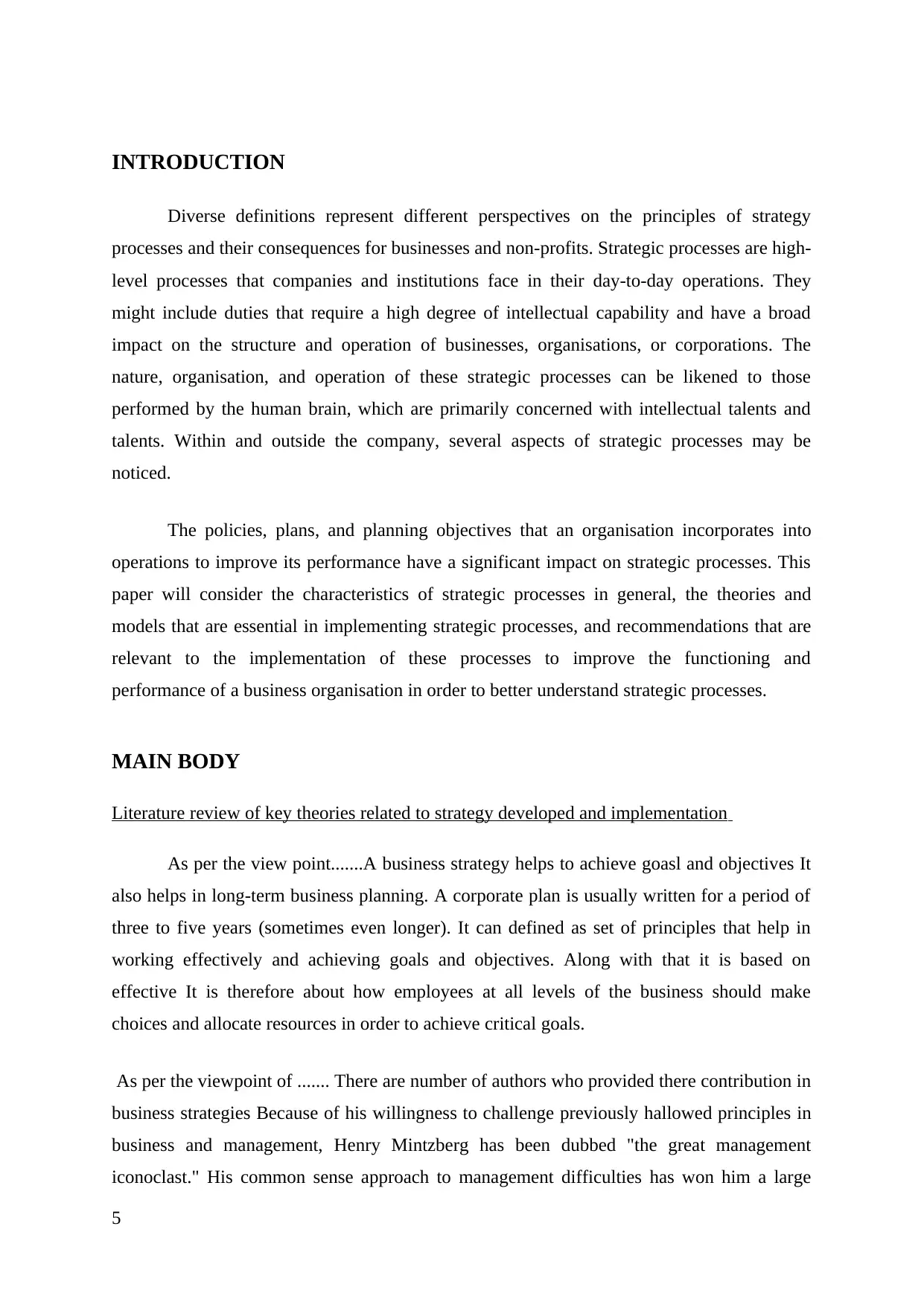
INTRODUCTION
Diverse definitions represent different perspectives on the principles of strategy
processes and their consequences for businesses and non-profits. Strategic processes are high-
level processes that companies and institutions face in their day-to-day operations. They
might include duties that require a high degree of intellectual capability and have a broad
impact on the structure and operation of businesses, organisations, or corporations. The
nature, organisation, and operation of these strategic processes can be likened to those
performed by the human brain, which are primarily concerned with intellectual talents and
talents. Within and outside the company, several aspects of strategic processes may be
noticed.
The policies, plans, and planning objectives that an organisation incorporates into
operations to improve its performance have a significant impact on strategic processes. This
paper will consider the characteristics of strategic processes in general, the theories and
models that are essential in implementing strategic processes, and recommendations that are
relevant to the implementation of these processes to improve the functioning and
performance of a business organisation in order to better understand strategic processes.
MAIN BODY
Literature review of key theories related to strategy developed and implementation
As per the view point.......A business strategy helps to achieve goasl and objectives It
also helps in long-term business planning. A corporate plan is usually written for a period of
three to five years (sometimes even longer). It can defined as set of principles that help in
working effectively and achieving goals and objectives. Along with that it is based on
effective It is therefore about how employees at all levels of the business should make
choices and allocate resources in order to achieve critical goals.
As per the viewpoint of ....... There are number of authors who provided there contribution in
business strategies Because of his willingness to challenge previously hallowed principles in
business and management, Henry Mintzberg has been dubbed "the great management
iconoclast." His common sense approach to management difficulties has won him a large
5
Diverse definitions represent different perspectives on the principles of strategy
processes and their consequences for businesses and non-profits. Strategic processes are high-
level processes that companies and institutions face in their day-to-day operations. They
might include duties that require a high degree of intellectual capability and have a broad
impact on the structure and operation of businesses, organisations, or corporations. The
nature, organisation, and operation of these strategic processes can be likened to those
performed by the human brain, which are primarily concerned with intellectual talents and
talents. Within and outside the company, several aspects of strategic processes may be
noticed.
The policies, plans, and planning objectives that an organisation incorporates into
operations to improve its performance have a significant impact on strategic processes. This
paper will consider the characteristics of strategic processes in general, the theories and
models that are essential in implementing strategic processes, and recommendations that are
relevant to the implementation of these processes to improve the functioning and
performance of a business organisation in order to better understand strategic processes.
MAIN BODY
Literature review of key theories related to strategy developed and implementation
As per the view point.......A business strategy helps to achieve goasl and objectives It
also helps in long-term business planning. A corporate plan is usually written for a period of
three to five years (sometimes even longer). It can defined as set of principles that help in
working effectively and achieving goals and objectives. Along with that it is based on
effective It is therefore about how employees at all levels of the business should make
choices and allocate resources in order to achieve critical goals.
As per the viewpoint of ....... There are number of authors who provided there contribution in
business strategies Because of his willingness to challenge previously hallowed principles in
business and management, Henry Mintzberg has been dubbed "the great management
iconoclast." His common sense approach to management difficulties has won him a large
5
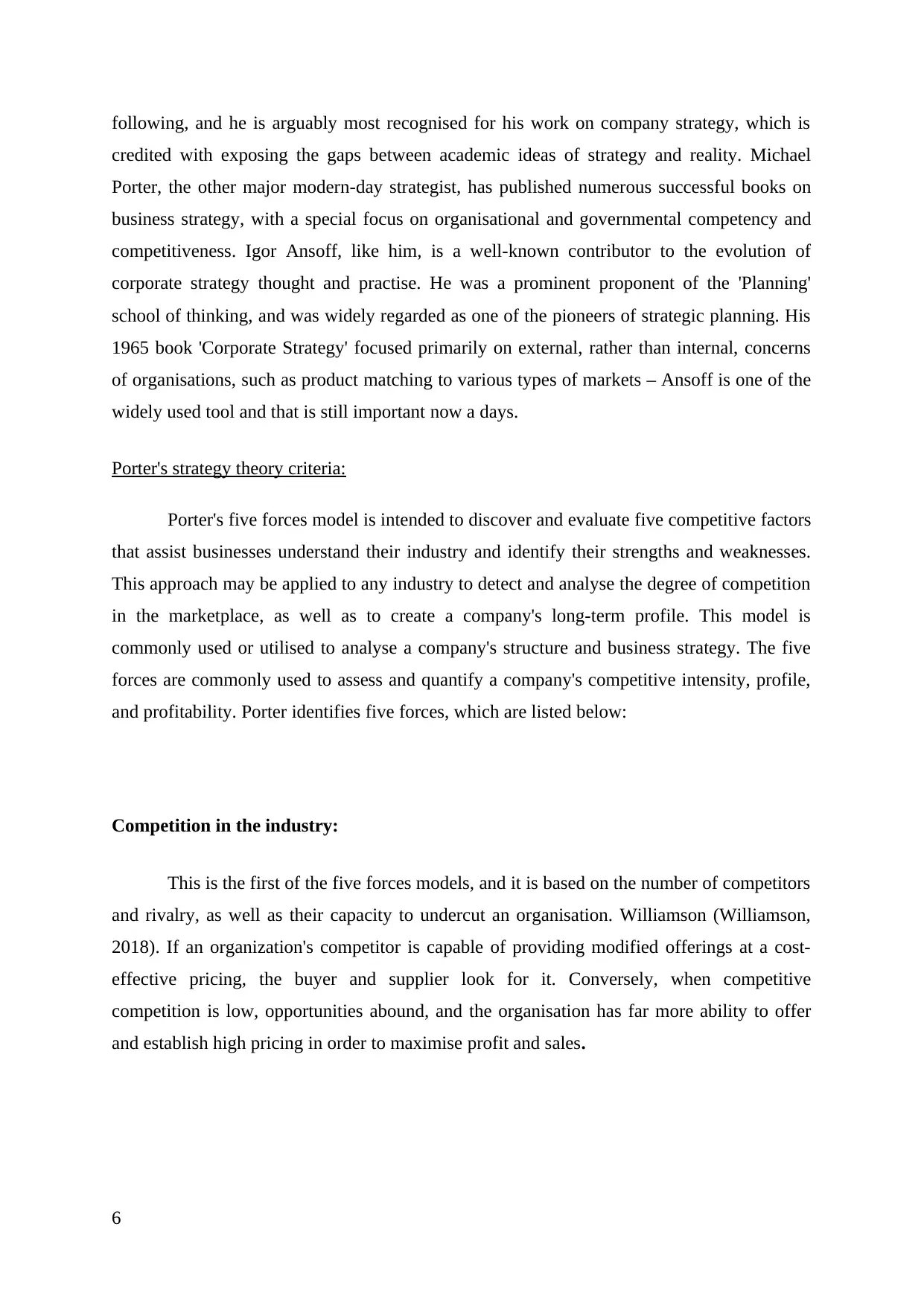
following, and he is arguably most recognised for his work on company strategy, which is
credited with exposing the gaps between academic ideas of strategy and reality. Michael
Porter, the other major modern-day strategist, has published numerous successful books on
business strategy, with a special focus on organisational and governmental competency and
competitiveness. Igor Ansoff, like him, is a well-known contributor to the evolution of
corporate strategy thought and practise. He was a prominent proponent of the 'Planning'
school of thinking, and was widely regarded as one of the pioneers of strategic planning. His
1965 book 'Corporate Strategy' focused primarily on external, rather than internal, concerns
of organisations, such as product matching to various types of markets – Ansoff is one of the
widely used tool and that is still important now a days.
Porter's strategy theory criteria:
Porter's five forces model is intended to discover and evaluate five competitive factors
that assist businesses understand their industry and identify their strengths and weaknesses.
This approach may be applied to any industry to detect and analyse the degree of competition
in the marketplace, as well as to create a company's long-term profile. This model is
commonly used or utilised to analyse a company's structure and business strategy. The five
forces are commonly used to assess and quantify a company's competitive intensity, profile,
and profitability. Porter identifies five forces, which are listed below:
Competition in the industry:
This is the first of the five forces models, and it is based on the number of competitors
and rivalry, as well as their capacity to undercut an organisation. Williamson (Williamson,
2018). If an organization's competitor is capable of providing modified offerings at a cost-
effective pricing, the buyer and supplier look for it. Conversely, when competitive
competition is low, opportunities abound, and the organisation has far more ability to offer
and establish high pricing in order to maximise profit and sales.
6
credited with exposing the gaps between academic ideas of strategy and reality. Michael
Porter, the other major modern-day strategist, has published numerous successful books on
business strategy, with a special focus on organisational and governmental competency and
competitiveness. Igor Ansoff, like him, is a well-known contributor to the evolution of
corporate strategy thought and practise. He was a prominent proponent of the 'Planning'
school of thinking, and was widely regarded as one of the pioneers of strategic planning. His
1965 book 'Corporate Strategy' focused primarily on external, rather than internal, concerns
of organisations, such as product matching to various types of markets – Ansoff is one of the
widely used tool and that is still important now a days.
Porter's strategy theory criteria:
Porter's five forces model is intended to discover and evaluate five competitive factors
that assist businesses understand their industry and identify their strengths and weaknesses.
This approach may be applied to any industry to detect and analyse the degree of competition
in the marketplace, as well as to create a company's long-term profile. This model is
commonly used or utilised to analyse a company's structure and business strategy. The five
forces are commonly used to assess and quantify a company's competitive intensity, profile,
and profitability. Porter identifies five forces, which are listed below:
Competition in the industry:
This is the first of the five forces models, and it is based on the number of competitors
and rivalry, as well as their capacity to undercut an organisation. Williamson (Williamson,
2018). If an organization's competitor is capable of providing modified offerings at a cost-
effective pricing, the buyer and supplier look for it. Conversely, when competitive
competition is low, opportunities abound, and the organisation has far more ability to offer
and establish high pricing in order to maximise profit and sales.
6
⊘ This is a preview!⊘
Do you want full access?
Subscribe today to unlock all pages.

Trusted by 1+ million students worldwide
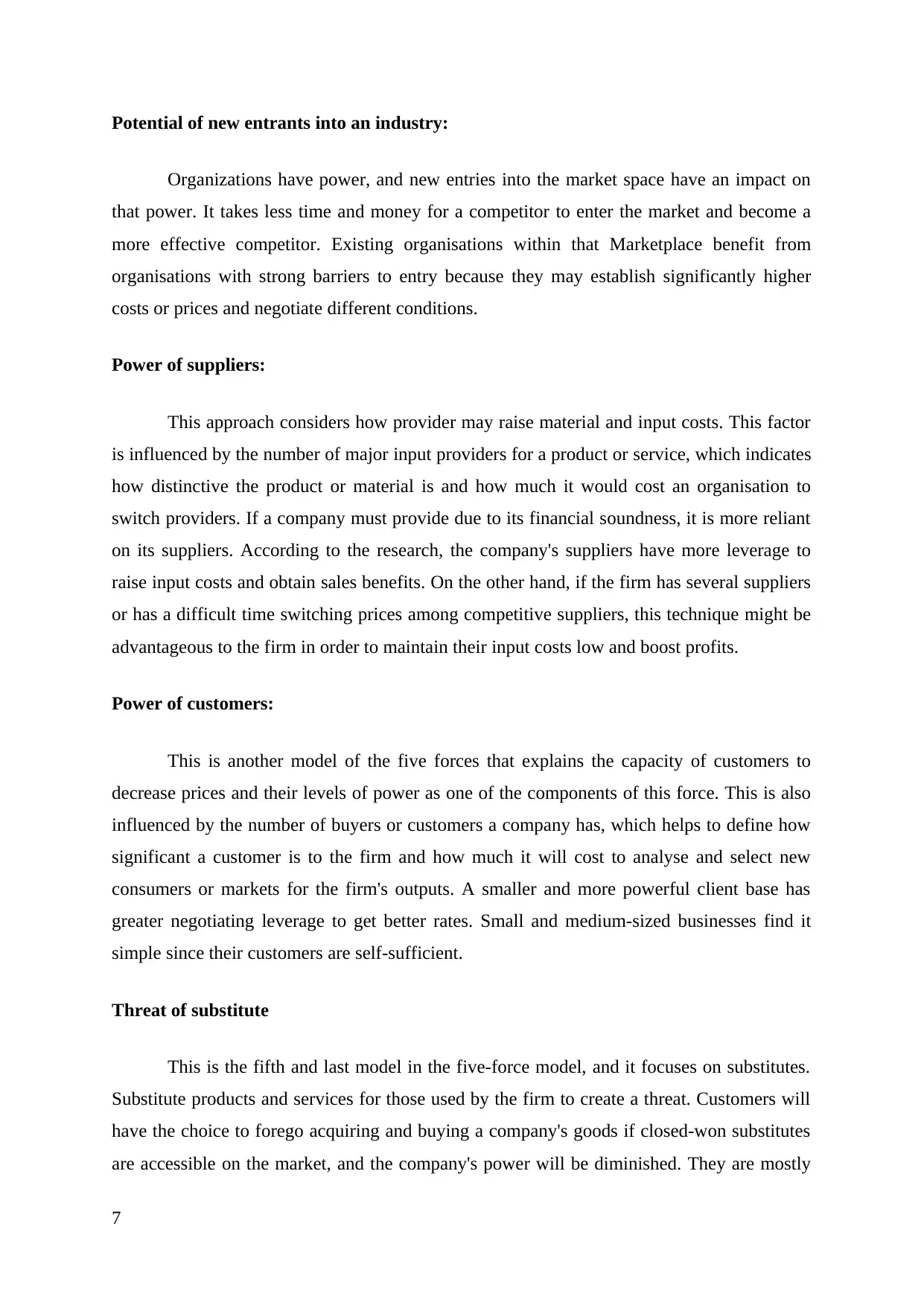
Potential of new entrants into an industry:
Organizations have power, and new entries into the market space have an impact on
that power. It takes less time and money for a competitor to enter the market and become a
more effective competitor. Existing organisations within that Marketplace benefit from
organisations with strong barriers to entry because they may establish significantly higher
costs or prices and negotiate different conditions.
Power of suppliers:
This approach considers how provider may raise material and input costs. This factor
is influenced by the number of major input providers for a product or service, which indicates
how distinctive the product or material is and how much it would cost an organisation to
switch providers. If a company must provide due to its financial soundness, it is more reliant
on its suppliers. According to the research, the company's suppliers have more leverage to
raise input costs and obtain sales benefits. On the other hand, if the firm has several suppliers
or has a difficult time switching prices among competitive suppliers, this technique might be
advantageous to the firm in order to maintain their input costs low and boost profits.
Power of customers:
This is another model of the five forces that explains the capacity of customers to
decrease prices and their levels of power as one of the components of this force. This is also
influenced by the number of buyers or customers a company has, which helps to define how
significant a customer is to the firm and how much it will cost to analyse and select new
consumers or markets for the firm's outputs. A smaller and more powerful client base has
greater negotiating leverage to get better rates. Small and medium-sized businesses find it
simple since their customers are self-sufficient.
Threat of substitute
This is the fifth and last model in the five-force model, and it focuses on substitutes.
Substitute products and services for those used by the firm to create a threat. Customers will
have the choice to forego acquiring and buying a company's goods if closed-won substitutes
are accessible on the market, and the company's power will be diminished. They are mostly
7
Organizations have power, and new entries into the market space have an impact on
that power. It takes less time and money for a competitor to enter the market and become a
more effective competitor. Existing organisations within that Marketplace benefit from
organisations with strong barriers to entry because they may establish significantly higher
costs or prices and negotiate different conditions.
Power of suppliers:
This approach considers how provider may raise material and input costs. This factor
is influenced by the number of major input providers for a product or service, which indicates
how distinctive the product or material is and how much it would cost an organisation to
switch providers. If a company must provide due to its financial soundness, it is more reliant
on its suppliers. According to the research, the company's suppliers have more leverage to
raise input costs and obtain sales benefits. On the other hand, if the firm has several suppliers
or has a difficult time switching prices among competitive suppliers, this technique might be
advantageous to the firm in order to maintain their input costs low and boost profits.
Power of customers:
This is another model of the five forces that explains the capacity of customers to
decrease prices and their levels of power as one of the components of this force. This is also
influenced by the number of buyers or customers a company has, which helps to define how
significant a customer is to the firm and how much it will cost to analyse and select new
consumers or markets for the firm's outputs. A smaller and more powerful client base has
greater negotiating leverage to get better rates. Small and medium-sized businesses find it
simple since their customers are self-sufficient.
Threat of substitute
This is the fifth and last model in the five-force model, and it focuses on substitutes.
Substitute products and services for those used by the firm to create a threat. Customers will
have the choice to forego acquiring and buying a company's goods if closed-won substitutes
are accessible on the market, and the company's power will be diminished. They are mostly
7
Paraphrase This Document
Need a fresh take? Get an instant paraphrase of this document with our AI Paraphraser
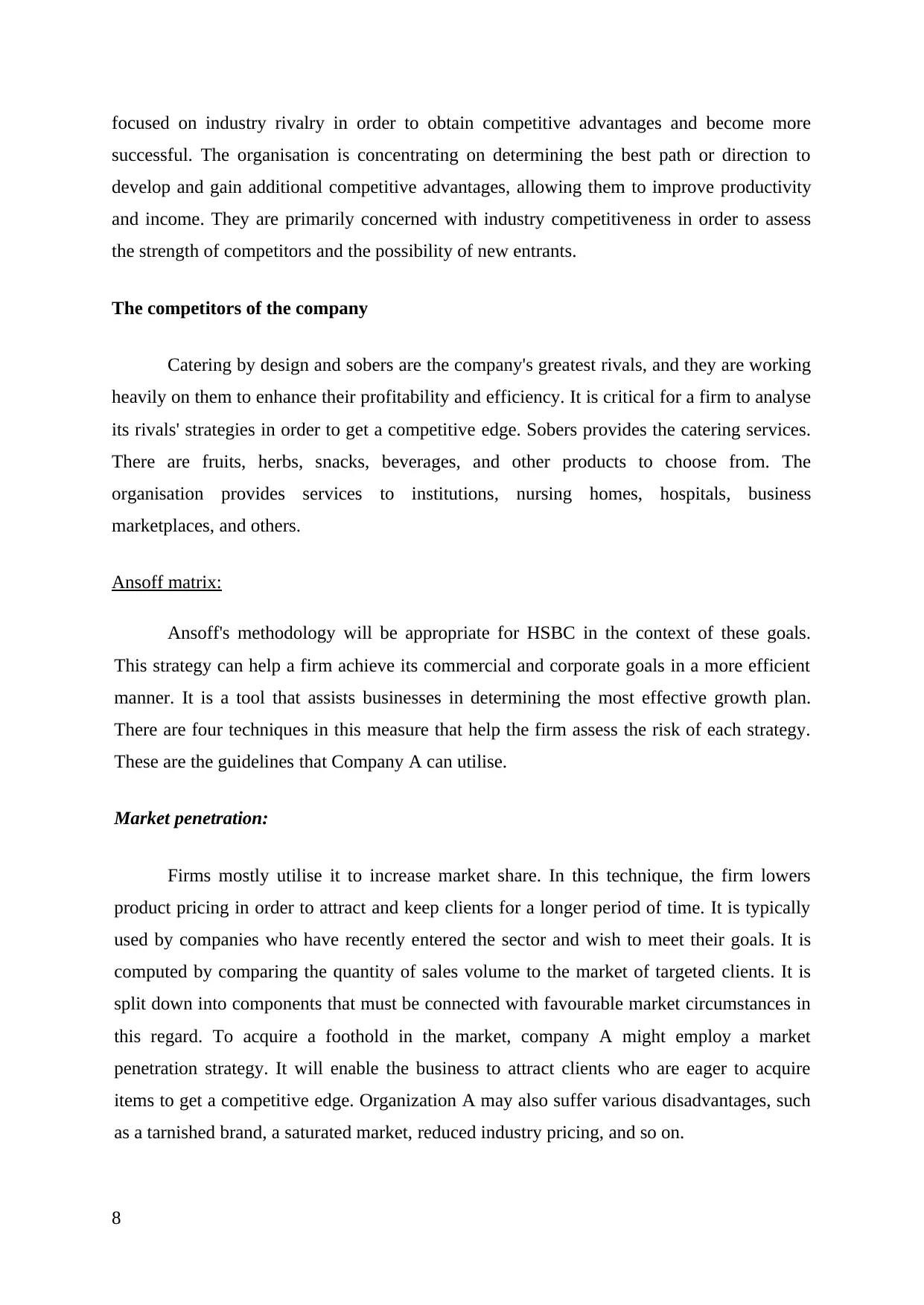
focused on industry rivalry in order to obtain competitive advantages and become more
successful. The organisation is concentrating on determining the best path or direction to
develop and gain additional competitive advantages, allowing them to improve productivity
and income. They are primarily concerned with industry competitiveness in order to assess
the strength of competitors and the possibility of new entrants.
The competitors of the company
Catering by design and sobers are the company's greatest rivals, and they are working
heavily on them to enhance their profitability and efficiency. It is critical for a firm to analyse
its rivals' strategies in order to get a competitive edge. Sobers provides the catering services.
There are fruits, herbs, snacks, beverages, and other products to choose from. The
organisation provides services to institutions, nursing homes, hospitals, business
marketplaces, and others.
Ansoff matrix:
Ansoff's methodology will be appropriate for HSBC in the context of these goals.
This strategy can help a firm achieve its commercial and corporate goals in a more efficient
manner. It is a tool that assists businesses in determining the most effective growth plan.
There are four techniques in this measure that help the firm assess the risk of each strategy.
These are the guidelines that Company A can utilise.
Market penetration:
Firms mostly utilise it to increase market share. In this technique, the firm lowers
product pricing in order to attract and keep clients for a longer period of time. It is typically
used by companies who have recently entered the sector and wish to meet their goals. It is
computed by comparing the quantity of sales volume to the market of targeted clients. It is
split down into components that must be connected with favourable market circumstances in
this regard. To acquire a foothold in the market, company A might employ a market
penetration strategy. It will enable the business to attract clients who are eager to acquire
items to get a competitive edge. Organization A may also suffer various disadvantages, such
as a tarnished brand, a saturated market, reduced industry pricing, and so on.
8
successful. The organisation is concentrating on determining the best path or direction to
develop and gain additional competitive advantages, allowing them to improve productivity
and income. They are primarily concerned with industry competitiveness in order to assess
the strength of competitors and the possibility of new entrants.
The competitors of the company
Catering by design and sobers are the company's greatest rivals, and they are working
heavily on them to enhance their profitability and efficiency. It is critical for a firm to analyse
its rivals' strategies in order to get a competitive edge. Sobers provides the catering services.
There are fruits, herbs, snacks, beverages, and other products to choose from. The
organisation provides services to institutions, nursing homes, hospitals, business
marketplaces, and others.
Ansoff matrix:
Ansoff's methodology will be appropriate for HSBC in the context of these goals.
This strategy can help a firm achieve its commercial and corporate goals in a more efficient
manner. It is a tool that assists businesses in determining the most effective growth plan.
There are four techniques in this measure that help the firm assess the risk of each strategy.
These are the guidelines that Company A can utilise.
Market penetration:
Firms mostly utilise it to increase market share. In this technique, the firm lowers
product pricing in order to attract and keep clients for a longer period of time. It is typically
used by companies who have recently entered the sector and wish to meet their goals. It is
computed by comparing the quantity of sales volume to the market of targeted clients. It is
split down into components that must be connected with favourable market circumstances in
this regard. To acquire a foothold in the market, company A might employ a market
penetration strategy. It will enable the business to attract clients who are eager to acquire
items to get a competitive edge. Organization A may also suffer various disadvantages, such
as a tarnished brand, a saturated market, reduced industry pricing, and so on.
8
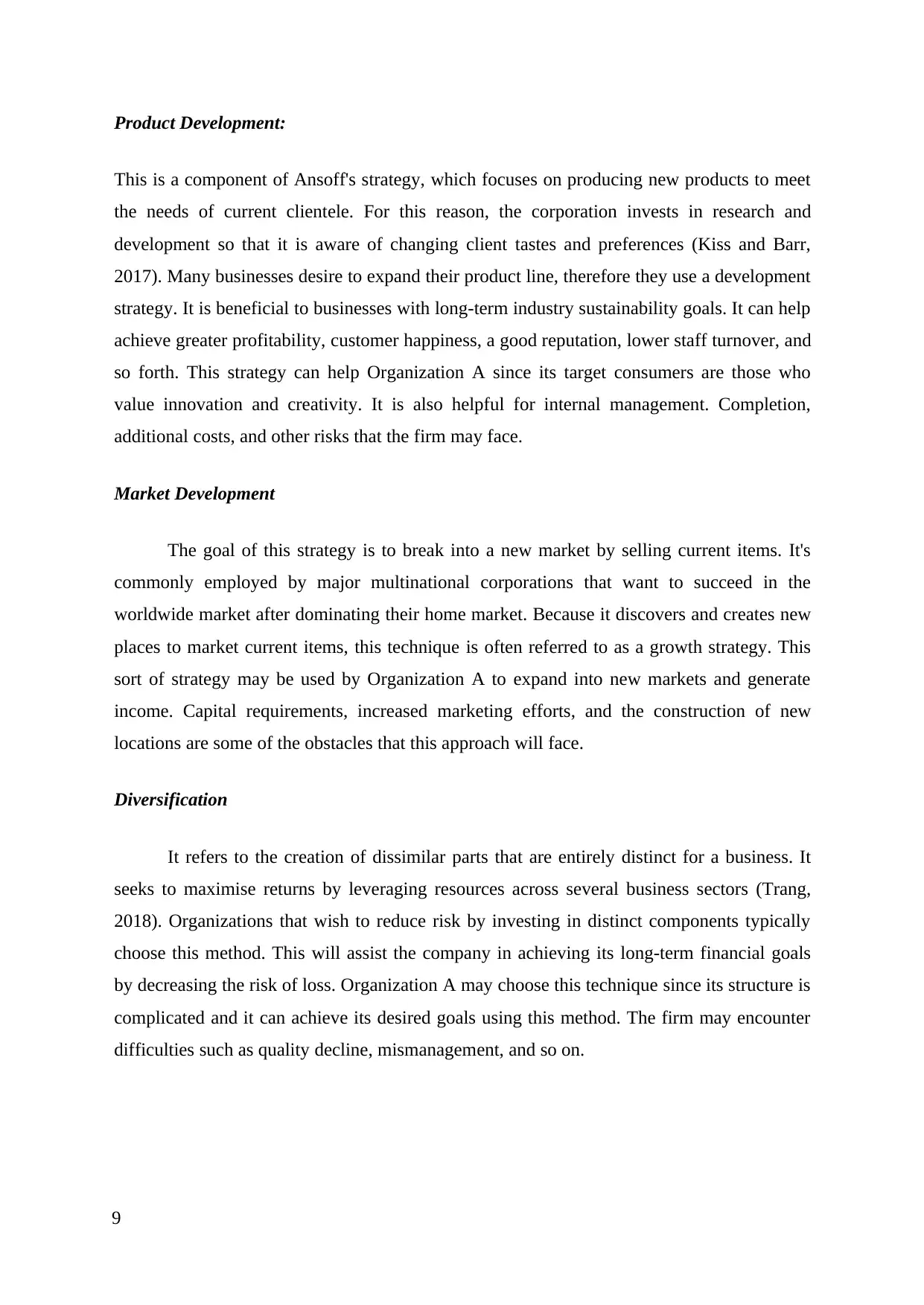
Product Development:
This is a component of Ansoff's strategy, which focuses on producing new products to meet
the needs of current clientele. For this reason, the corporation invests in research and
development so that it is aware of changing client tastes and preferences (Kiss and Barr,
2017). Many businesses desire to expand their product line, therefore they use a development
strategy. It is beneficial to businesses with long-term industry sustainability goals. It can help
achieve greater profitability, customer happiness, a good reputation, lower staff turnover, and
so forth. This strategy can help Organization A since its target consumers are those who
value innovation and creativity. It is also helpful for internal management. Completion,
additional costs, and other risks that the firm may face.
Market Development
The goal of this strategy is to break into a new market by selling current items. It's
commonly employed by major multinational corporations that want to succeed in the
worldwide market after dominating their home market. Because it discovers and creates new
places to market current items, this technique is often referred to as a growth strategy. This
sort of strategy may be used by Organization A to expand into new markets and generate
income. Capital requirements, increased marketing efforts, and the construction of new
locations are some of the obstacles that this approach will face.
Diversification
It refers to the creation of dissimilar parts that are entirely distinct for a business. It
seeks to maximise returns by leveraging resources across several business sectors (Trang,
2018). Organizations that wish to reduce risk by investing in distinct components typically
choose this method. This will assist the company in achieving its long-term financial goals
by decreasing the risk of loss. Organization A may choose this technique since its structure is
complicated and it can achieve its desired goals using this method. The firm may encounter
difficulties such as quality decline, mismanagement, and so on.
9
This is a component of Ansoff's strategy, which focuses on producing new products to meet
the needs of current clientele. For this reason, the corporation invests in research and
development so that it is aware of changing client tastes and preferences (Kiss and Barr,
2017). Many businesses desire to expand their product line, therefore they use a development
strategy. It is beneficial to businesses with long-term industry sustainability goals. It can help
achieve greater profitability, customer happiness, a good reputation, lower staff turnover, and
so forth. This strategy can help Organization A since its target consumers are those who
value innovation and creativity. It is also helpful for internal management. Completion,
additional costs, and other risks that the firm may face.
Market Development
The goal of this strategy is to break into a new market by selling current items. It's
commonly employed by major multinational corporations that want to succeed in the
worldwide market after dominating their home market. Because it discovers and creates new
places to market current items, this technique is often referred to as a growth strategy. This
sort of strategy may be used by Organization A to expand into new markets and generate
income. Capital requirements, increased marketing efforts, and the construction of new
locations are some of the obstacles that this approach will face.
Diversification
It refers to the creation of dissimilar parts that are entirely distinct for a business. It
seeks to maximise returns by leveraging resources across several business sectors (Trang,
2018). Organizations that wish to reduce risk by investing in distinct components typically
choose this method. This will assist the company in achieving its long-term financial goals
by decreasing the risk of loss. Organization A may choose this technique since its structure is
complicated and it can achieve its desired goals using this method. The firm may encounter
difficulties such as quality decline, mismanagement, and so on.
9
⊘ This is a preview!⊘
Do you want full access?
Subscribe today to unlock all pages.

Trusted by 1+ million students worldwide
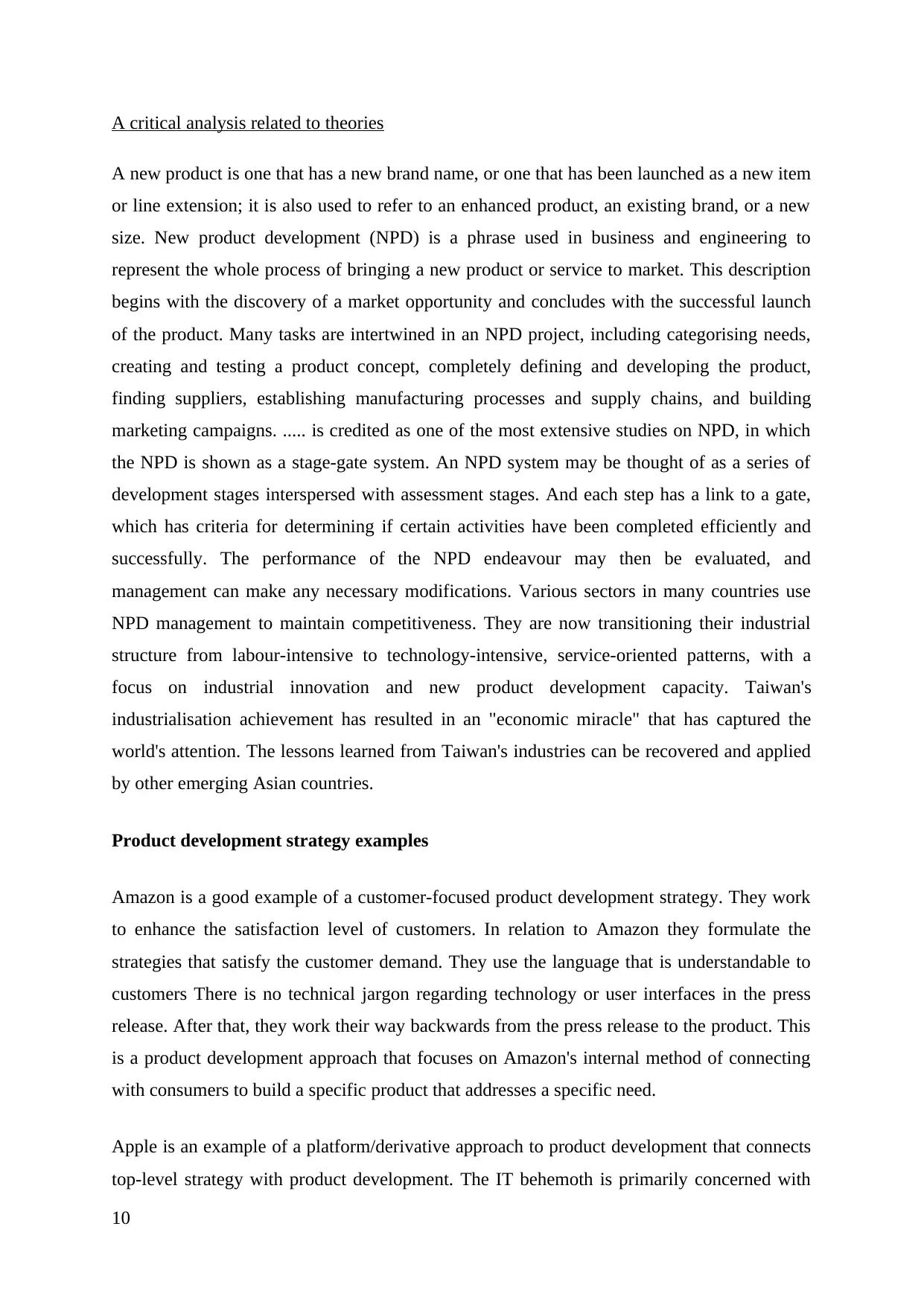
A critical analysis related to theories
A new product is one that has a new brand name, or one that has been launched as a new item
or line extension; it is also used to refer to an enhanced product, an existing brand, or a new
size. New product development (NPD) is a phrase used in business and engineering to
represent the whole process of bringing a new product or service to market. This description
begins with the discovery of a market opportunity and concludes with the successful launch
of the product. Many tasks are intertwined in an NPD project, including categorising needs,
creating and testing a product concept, completely defining and developing the product,
finding suppliers, establishing manufacturing processes and supply chains, and building
marketing campaigns. ..... is credited as one of the most extensive studies on NPD, in which
the NPD is shown as a stage-gate system. An NPD system may be thought of as a series of
development stages interspersed with assessment stages. And each step has a link to a gate,
which has criteria for determining if certain activities have been completed efficiently and
successfully. The performance of the NPD endeavour may then be evaluated, and
management can make any necessary modifications. Various sectors in many countries use
NPD management to maintain competitiveness. They are now transitioning their industrial
structure from labour-intensive to technology-intensive, service-oriented patterns, with a
focus on industrial innovation and new product development capacity. Taiwan's
industrialisation achievement has resulted in an "economic miracle" that has captured the
world's attention. The lessons learned from Taiwan's industries can be recovered and applied
by other emerging Asian countries.
Product development strategy examples
Amazon is a good example of a customer-focused product development strategy. They work
to enhance the satisfaction level of customers. In relation to Amazon they formulate the
strategies that satisfy the customer demand. They use the language that is understandable to
customers There is no technical jargon regarding technology or user interfaces in the press
release. After that, they work their way backwards from the press release to the product. This
is a product development approach that focuses on Amazon's internal method of connecting
with consumers to build a specific product that addresses a specific need.
Apple is an example of a platform/derivative approach to product development that connects
top-level strategy with product development. The IT behemoth is primarily concerned with
10
A new product is one that has a new brand name, or one that has been launched as a new item
or line extension; it is also used to refer to an enhanced product, an existing brand, or a new
size. New product development (NPD) is a phrase used in business and engineering to
represent the whole process of bringing a new product or service to market. This description
begins with the discovery of a market opportunity and concludes with the successful launch
of the product. Many tasks are intertwined in an NPD project, including categorising needs,
creating and testing a product concept, completely defining and developing the product,
finding suppliers, establishing manufacturing processes and supply chains, and building
marketing campaigns. ..... is credited as one of the most extensive studies on NPD, in which
the NPD is shown as a stage-gate system. An NPD system may be thought of as a series of
development stages interspersed with assessment stages. And each step has a link to a gate,
which has criteria for determining if certain activities have been completed efficiently and
successfully. The performance of the NPD endeavour may then be evaluated, and
management can make any necessary modifications. Various sectors in many countries use
NPD management to maintain competitiveness. They are now transitioning their industrial
structure from labour-intensive to technology-intensive, service-oriented patterns, with a
focus on industrial innovation and new product development capacity. Taiwan's
industrialisation achievement has resulted in an "economic miracle" that has captured the
world's attention. The lessons learned from Taiwan's industries can be recovered and applied
by other emerging Asian countries.
Product development strategy examples
Amazon is a good example of a customer-focused product development strategy. They work
to enhance the satisfaction level of customers. In relation to Amazon they formulate the
strategies that satisfy the customer demand. They use the language that is understandable to
customers There is no technical jargon regarding technology or user interfaces in the press
release. After that, they work their way backwards from the press release to the product. This
is a product development approach that focuses on Amazon's internal method of connecting
with consumers to build a specific product that addresses a specific need.
Apple is an example of a platform/derivative approach to product development that connects
top-level strategy with product development. The IT behemoth is primarily concerned with
10
Paraphrase This Document
Need a fresh take? Get an instant paraphrase of this document with our AI Paraphraser
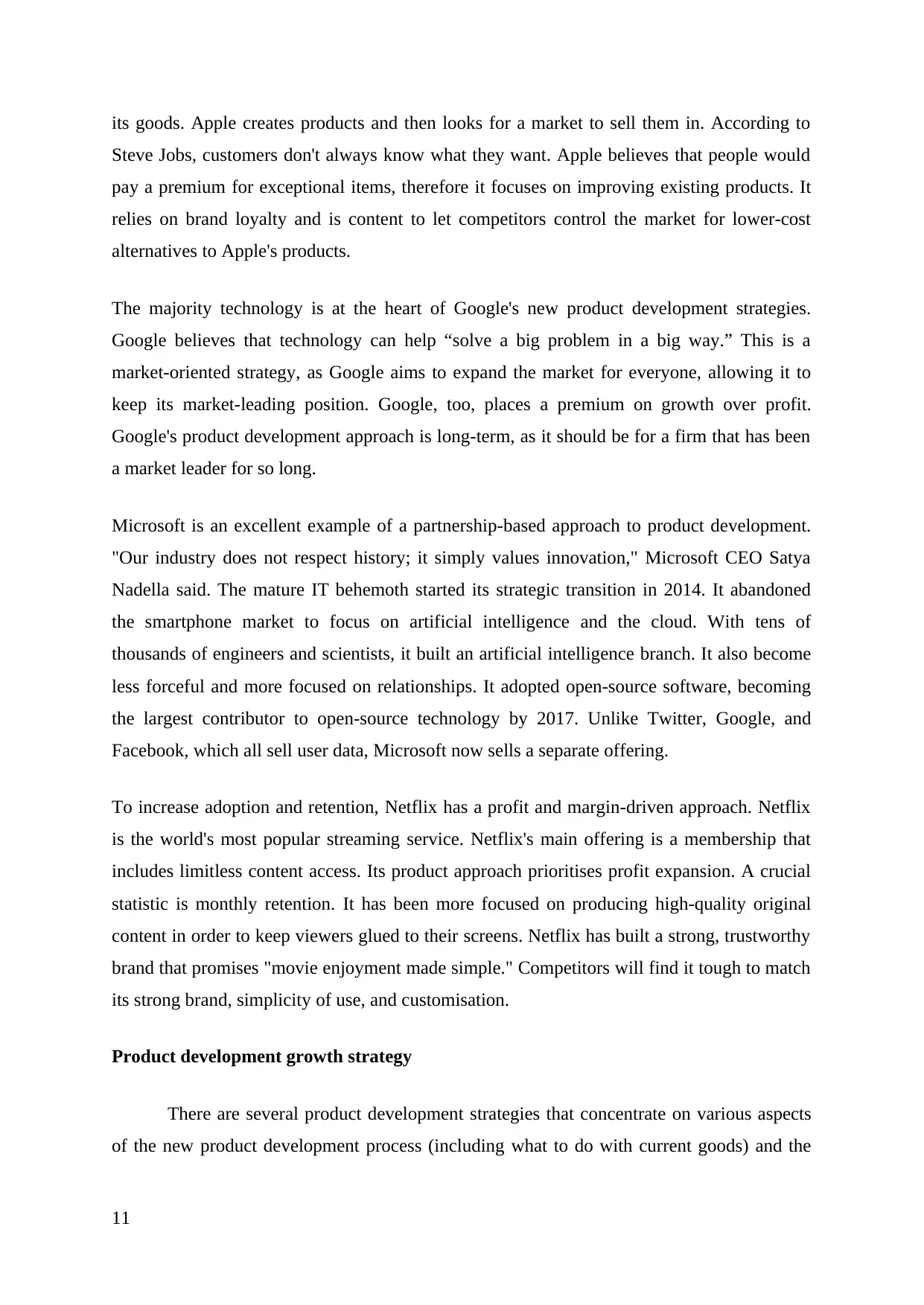
its goods. Apple creates products and then looks for a market to sell them in. According to
Steve Jobs, customers don't always know what they want. Apple believes that people would
pay a premium for exceptional items, therefore it focuses on improving existing products. It
relies on brand loyalty and is content to let competitors control the market for lower-cost
alternatives to Apple's products.
The majority technology is at the heart of Google's new product development strategies.
Google believes that technology can help “solve a big problem in a big way.” This is a
market-oriented strategy, as Google aims to expand the market for everyone, allowing it to
keep its market-leading position. Google, too, places a premium on growth over profit.
Google's product development approach is long-term, as it should be for a firm that has been
a market leader for so long.
Microsoft is an excellent example of a partnership-based approach to product development.
"Our industry does not respect history; it simply values innovation," Microsoft CEO Satya
Nadella said. The mature IT behemoth started its strategic transition in 2014. It abandoned
the smartphone market to focus on artificial intelligence and the cloud. With tens of
thousands of engineers and scientists, it built an artificial intelligence branch. It also become
less forceful and more focused on relationships. It adopted open-source software, becoming
the largest contributor to open-source technology by 2017. Unlike Twitter, Google, and
Facebook, which all sell user data, Microsoft now sells a separate offering.
To increase adoption and retention, Netflix has a profit and margin-driven approach. Netflix
is the world's most popular streaming service. Netflix's main offering is a membership that
includes limitless content access. Its product approach prioritises profit expansion. A crucial
statistic is monthly retention. It has been more focused on producing high-quality original
content in order to keep viewers glued to their screens. Netflix has built a strong, trustworthy
brand that promises "movie enjoyment made simple." Competitors will find it tough to match
its strong brand, simplicity of use, and customisation.
Product development growth strategy
There are several product development strategies that concentrate on various aspects
of the new product development process (including what to do with current goods) and the
11
Steve Jobs, customers don't always know what they want. Apple believes that people would
pay a premium for exceptional items, therefore it focuses on improving existing products. It
relies on brand loyalty and is content to let competitors control the market for lower-cost
alternatives to Apple's products.
The majority technology is at the heart of Google's new product development strategies.
Google believes that technology can help “solve a big problem in a big way.” This is a
market-oriented strategy, as Google aims to expand the market for everyone, allowing it to
keep its market-leading position. Google, too, places a premium on growth over profit.
Google's product development approach is long-term, as it should be for a firm that has been
a market leader for so long.
Microsoft is an excellent example of a partnership-based approach to product development.
"Our industry does not respect history; it simply values innovation," Microsoft CEO Satya
Nadella said. The mature IT behemoth started its strategic transition in 2014. It abandoned
the smartphone market to focus on artificial intelligence and the cloud. With tens of
thousands of engineers and scientists, it built an artificial intelligence branch. It also become
less forceful and more focused on relationships. It adopted open-source software, becoming
the largest contributor to open-source technology by 2017. Unlike Twitter, Google, and
Facebook, which all sell user data, Microsoft now sells a separate offering.
To increase adoption and retention, Netflix has a profit and margin-driven approach. Netflix
is the world's most popular streaming service. Netflix's main offering is a membership that
includes limitless content access. Its product approach prioritises profit expansion. A crucial
statistic is monthly retention. It has been more focused on producing high-quality original
content in order to keep viewers glued to their screens. Netflix has built a strong, trustworthy
brand that promises "movie enjoyment made simple." Competitors will find it tough to match
its strong brand, simplicity of use, and customisation.
Product development growth strategy
There are several product development strategies that concentrate on various aspects
of the new product development process (including what to do with current goods) and the
11
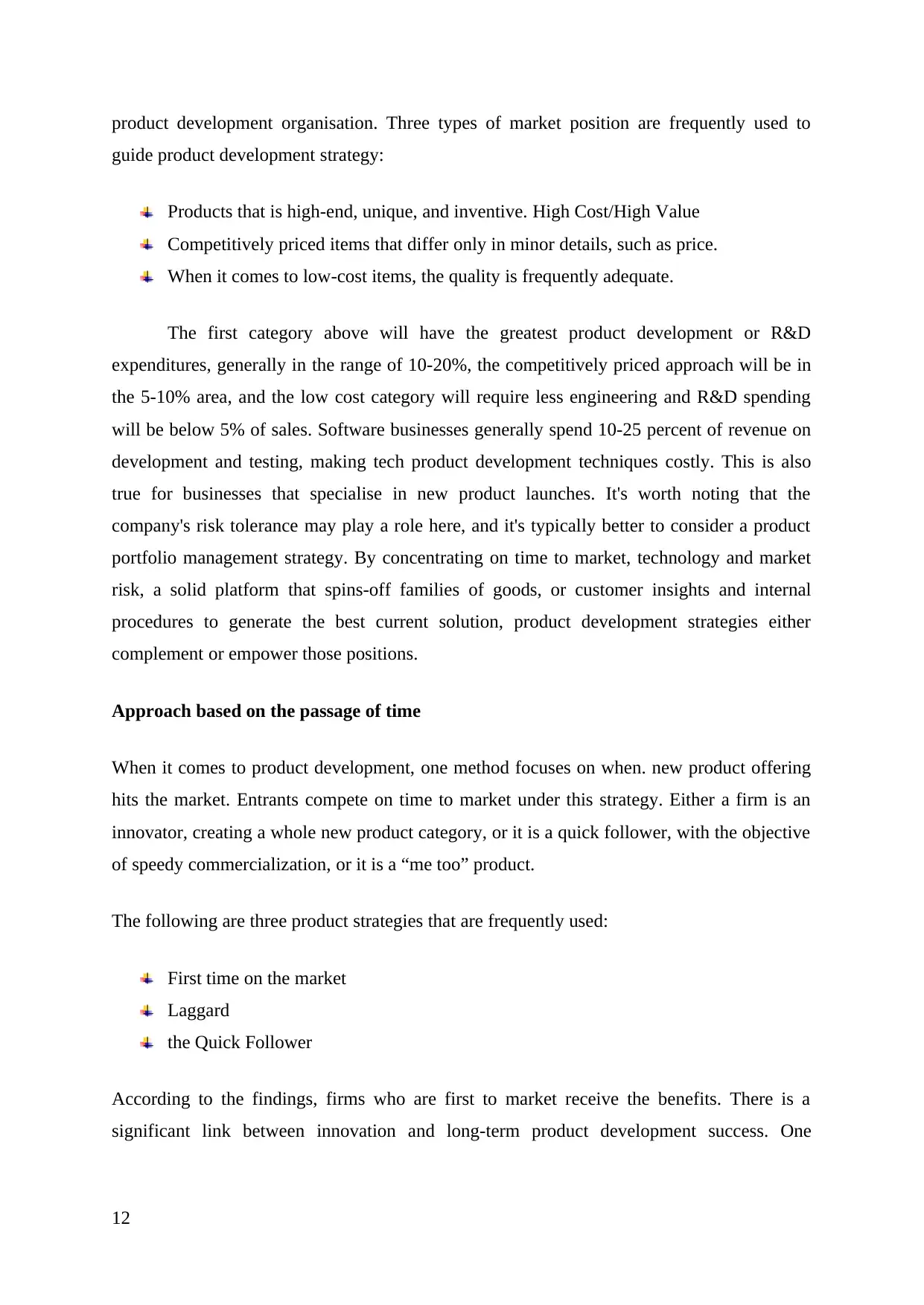
product development organisation. Three types of market position are frequently used to
guide product development strategy:
Products that is high-end, unique, and inventive. High Cost/High Value
Competitively priced items that differ only in minor details, such as price.
When it comes to low-cost items, the quality is frequently adequate.
The first category above will have the greatest product development or R&D
expenditures, generally in the range of 10-20%, the competitively priced approach will be in
the 5-10% area, and the low cost category will require less engineering and R&D spending
will be below 5% of sales. Software businesses generally spend 10-25 percent of revenue on
development and testing, making tech product development techniques costly. This is also
true for businesses that specialise in new product launches. It's worth noting that the
company's risk tolerance may play a role here, and it's typically better to consider a product
portfolio management strategy. By concentrating on time to market, technology and market
risk, a solid platform that spins-off families of goods, or customer insights and internal
procedures to generate the best current solution, product development strategies either
complement or empower those positions.
Approach based on the passage of time
When it comes to product development, one method focuses on when. new product offering
hits the market. Entrants compete on time to market under this strategy. Either a firm is an
innovator, creating a whole new product category, or it is a quick follower, with the objective
of speedy commercialization, or it is a “me too” product.
The following are three product strategies that are frequently used:
First time on the market
Laggard
the Quick Follower
According to the findings, firms who are first to market receive the benefits. There is a
significant link between innovation and long-term product development success. One
12
guide product development strategy:
Products that is high-end, unique, and inventive. High Cost/High Value
Competitively priced items that differ only in minor details, such as price.
When it comes to low-cost items, the quality is frequently adequate.
The first category above will have the greatest product development or R&D
expenditures, generally in the range of 10-20%, the competitively priced approach will be in
the 5-10% area, and the low cost category will require less engineering and R&D spending
will be below 5% of sales. Software businesses generally spend 10-25 percent of revenue on
development and testing, making tech product development techniques costly. This is also
true for businesses that specialise in new product launches. It's worth noting that the
company's risk tolerance may play a role here, and it's typically better to consider a product
portfolio management strategy. By concentrating on time to market, technology and market
risk, a solid platform that spins-off families of goods, or customer insights and internal
procedures to generate the best current solution, product development strategies either
complement or empower those positions.
Approach based on the passage of time
When it comes to product development, one method focuses on when. new product offering
hits the market. Entrants compete on time to market under this strategy. Either a firm is an
innovator, creating a whole new product category, or it is a quick follower, with the objective
of speedy commercialization, or it is a “me too” product.
The following are three product strategies that are frequently used:
First time on the market
Laggard
the Quick Follower
According to the findings, firms who are first to market receive the benefits. There is a
significant link between innovation and long-term product development success. One
12
⊘ This is a preview!⊘
Do you want full access?
Subscribe today to unlock all pages.

Trusted by 1+ million students worldwide
1 out of 22
Related Documents
Your All-in-One AI-Powered Toolkit for Academic Success.
+13062052269
info@desklib.com
Available 24*7 on WhatsApp / Email
![[object Object]](/_next/static/media/star-bottom.7253800d.svg)
Unlock your academic potential
Copyright © 2020–2025 A2Z Services. All Rights Reserved. Developed and managed by ZUCOL.




